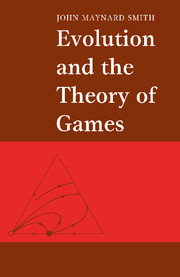Book contents
- Frontmatter
- Contents
- Preface
- 1 Introduction
- 2 The basic model
- 3 The war of attrition
- 4 Games with genetic models
- 5 Learning the ESS
- 6 Mixed strategies – I. A classification of mechanisms
- 7 Mixed strategies – II. Examples
- 8 Asymmetric games – I. Ownership
- 9 Asymmetric games – II. A classification, and some illustrative examples
- 10 Asymmetric games – III. Sex and generation games
- 11 Life history strategies and the size game
- 12 Honesty, bargaining and commitment
- 13 The evolution of cooperation
- 14 Postscript
- Appendixes
- Explanation of main terms
- References
- Subject index
- Author index
11 - Life history strategies and the size game
Published online by Cambridge University Press: 05 June 2012
- Frontmatter
- Contents
- Preface
- 1 Introduction
- 2 The basic model
- 3 The war of attrition
- 4 Games with genetic models
- 5 Learning the ESS
- 6 Mixed strategies – I. A classification of mechanisms
- 7 Mixed strategies – II. Examples
- 8 Asymmetric games – I. Ownership
- 9 Asymmetric games – II. A classification, and some illustrative examples
- 10 Asymmetric games – III. Sex and generation games
- 11 Life history strategies and the size game
- 12 Honesty, bargaining and commitment
- 13 The evolution of cooperation
- 14 Postscript
- Appendixes
- Explanation of main terms
- References
- Subject index
- Author index
Summary
There is a substantial body of work on the evolution of life history strategies; for reviews, see Stearns (1976) and Charlesworth (1980, ch. 5). The problem concerns the allocation of resources between survival, growth and reproduction. Most previous analyses have treated it as a ‘game against nature’; that is, as a problem in optimisation with fixed constraints on rates of growth, mortality and fecundity. An exception is the analysis by Mirmirani & Oster (1978) of plant growth. The rate of growth of a plant will depend on its own size, and also on the size of its neighbours and the intensity of competition from them for light, water and nutrients. The optimal strategy – i.e. that strategy which allocates resources between growth and reproduction so as to maximise total reproduction output – will be different for a plant growing by itself and for one growing in competition with others. In the latter case, we have to find an evolutionarily stable growth strategy. Mirmirani & Oster consider the additional complication that neighbours may be relatives, but this possibility will be ignored in what follows.
The search for evolutionarily stable life history strategies will be difficult. In this chapter, I consider only one special case. The animal I had in mind when formulating this model was the male red deer. In the late autumn, the stags hold harems of up to 15 hinds.
- Type
- Chapter
- Information
- Evolution and the Theory of Games , pp. 140 - 146Publisher: Cambridge University PressPrint publication year: 1982



